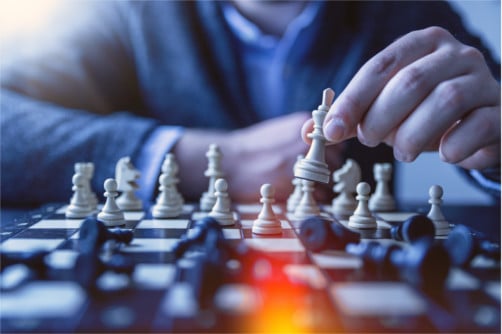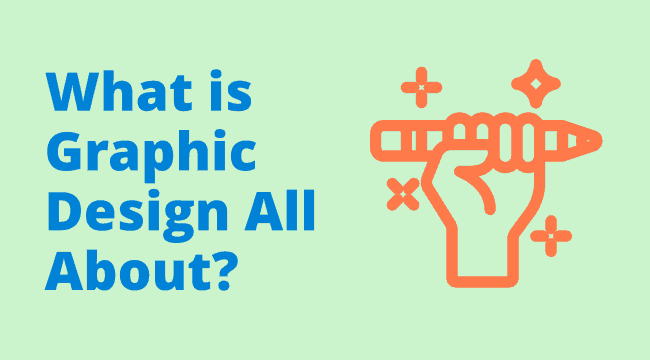So you want to know what graphic design is all about?
It’s a completely reasonable question. It’s a question I asked many years ago and one that gets asked by anyone trying to learn graphic design.
It’s not only a reasonable question, it’s completely crucial, since in order to learn something we need to define the boundaries of what has to be learned.
In order to become a graphic designer, you first need to understand what exactly graphic design is, it’s purpose, and why it’s important.
This can be a lot, but we can define graphic design in simple terms:
In a nutshell, graphic design is the process of strategically combining and manipulating information in order to present it visually. Simply put, it is the act of creating visual representations for the purpose of effective communication.
Let’s look at graphic design more closely.
MY NEW ONLINE COURSE
Thinking Like a Designer
Learn my proven method to finally understand the rules of any design and jumpstart your path to become an effective graphic designer

First, a definition of design in the general sense
Before plunging into theories and principles of design, graphics software, and skills tutorials, take a moment to think about the nature of design work.
Graphic design itself is a branch of design in the more abstract, or broad, sense. Design, as general discipline, has many levels of complexity, areas of application, and degrees of difficulty.
Design in this broad sense implies the full understanding and mastery of a process that applies to any act of human creation. That said, there are many sub-specializations of design: engineering design, interior design, information design, aeronautic design, etc.
Each has its own application and operation, each has its own level of complexity.
Design can then be defined as a process of creation. It is always purpose-oriented: it seeks to accomplish some well-defined purpose. The process of design, at the very least, implies strategy, hierarchy, selection, and manipulation.
But here’s the deal:
We can’t call every single act of creation “design,” since the act of designing implies a process of very specific actions or operations.
Some types of creation, say painting, may follow a broad plan or no plan at all. they may come from a “gut feeling” or from the “heart”.
But not design:
Design entails steps that are repeatable from project to project and that can be learned.
Let’s see in more detail what I mean:
What exactly is graphic design then?
If we see graphic design as part of design in the broader sense, we can say that graphic design is the process through which we strategically combine elements and principles in order to create visual artifacts of high communication value.
It’s important to describe the task of graphic design in order to understand what it is and, more importantly, what it is not. By doing this, we demystify graphic design as an essentially artistic activity. We get to see its procedural nature, which renders the task of learning graphic design easier and more approachable.
Below, I discuss key characteristics of graphic design in order to show you that it is a process that can be learned. Pay attention to what makes graphic design unique and how it’s different from other creative processes, such as creating art.
1 . Graphic design is different from art
Many times, we have heard that the artist works from the “heart.” This means that he or she follows some kind of instinctual voice, a “gut feeling,” that defines the creation as an inspired object. If you watch an artist work, such as Jean Michel Basquiat, you will see a “spontaneous” act of creation, a process that doesn’t have a fixed or guaranteed outcome.
We also often hear that art is always “open for interpretation.” Its effect is closer to an experience than to a specific message. Art “speaks” to us, but in ways that depend on context, history, frameworks of knowledge, and culture.
We can be both looking at a Pollock painting at the same place and time and yet experience different emotions and interpret different messages.
Even if most artists prepare themselves for the act of creation (in terms of planning, organization, or mapping), we tend to think of the artistic process as something that controls the artist, rather than the other way around. Art will take you where it will take you.
The graphic designer is different from the artist, and graphic design is different from the work of art.
The main difference lies in the primary purpose of graphic design: communication.
The primary objective of graphic designs are to render ideas, concepts, and events into a visual language for someone in some context. This language cannot be open to different interpretations and must be created according to predetermined parameters.
A graphic designer can be an artist, but you do not have to be an artist to be a graphic designer.
2. Graphic design is a form of visual communication
To say that graphic design is a form of visual communication is to acknowledge the importance of images in everyday life.
We live in a visual culture, and images have become the primary way of receiving and interpreting information. We rely on the visual for interpreting data, for making diagnoses, for expressing authority, and for selling stuff. Screens surround us and have become the quintessential channel for delivering images.
For visual communicators and graphic designers, images are a powerful vehicle for delivering messages because they are able to pack emotion and complexity in the most immediate, effective way.
To design is always to communicate. Communication, in this sense, is always a purposeful act, driven by clear objectives and processes.
3. Graphic design is strategy driven
Graphic designers create images that will accomplish a primary purpose, and this process of creation is guided by research, a specific message, technique, and an execution plan.

Graphic design does not occur by chance nor is the product of pure instinct. It is not random.
On the contrary, graphic designers take care in studying and really understanding their source material. They establish clear objectives based on a strategy for accomplishing their communication goals. They follow a system of production and workflow. They understand that simplicity and efficiency are essential elements of the creation process.
In other words:
The process of graphic design is a series of calculated steps that require skills, research, and strategy. It is planning and following through that plan to achieve a visual product.
4. Graphic design is a hierarchical process of selection
Graphic design concentrates on the minimum conditions that will render a message effective, and no more. In order to do this, graphic designers select what is most suited to accomplish a task. Excessive use of form or the over-manipulation of visual elements becomes an obstruction to clear communication.
A visual message carries within an intention. This intention must be distilled and rendered into its purest form. Selection becomes a crucial aspect of separating the important from the unimportant, the effective from the ineffective.
To select is to choose. Graphic designers are always choosing what is most effective to the task at hand.
5. Graphic design is manipulation
The first crucial step for graphic design is to “read”.
What I mean is this:
“Reading” here is a conscious absorption of content, a form of interpretation according to a code.
Design, as an objective-driven endeavor, implies the reading of the environment, the reading of messages (linguistic and otherwise), and the reading of the world.
Once graphic designers have read their source material (what they need to represent visually), they must engage in a second important step: to translate.
To translate means to take that knowledge, that understanding of the world that has been absorbed from the source material, and transport it to another plane of communication, the visual code.
In this sense, graphic designers manipulate language in order to communicate things in different ways. They also manipulate form (objects, icons, colors, textures) in order to create messages that are effective in communicating visually.
Conclusion: Graphic design is a process that you can learn
One of the main takeaway from this post is this:
You don’t necessarily have to be an “artist” in order to become a graphic designer.
Graphic design is a systematic, repeatable process that follows specific principles, actions, and objectives.
These principles and processes can be learned. With experience, practice, and understanding of what graphic design is about, you will be able to learn the basics of graphic design and start creating effective visual communication.
Summary: Remember these key points
- Graphic design is different from art: The product of graphic design should not be open for interpretation.
- Graphic design is driven by processes: Graphic designers work according to specific rules and steps.
- Graphic designers are visual communicators: Get your communication strategy first, then create graphics accordingly.
- Graphic design involves “reading” and “translating”: Graphic designers are really good at “reading,” or deeply absorbing, their environment. They focus on the details of things. The look at things very closely. Only then can they “translate” what they absorb into a visual language.
- Graphic design can be learned: You don’t have to be born an artist to be an effective visual communicator. Mostly, you will need knowledge, discipline, and experience. If you keep practicing, you will develop an eye for graphic design.
Now that you understand some key concepts about what graphic design is about, you can start to learn about the main principles that power effective visual communication and composition.
What do you think is the most important aspect of graphic design?
Let me know in a comment below and we’ll discuss it.
MY NEW ONLINE COURSE
Thinking Like a Designer
Learn my proven method to finally understand the rules of any design and jumpstart your path to become an effective graphic designer

Featured image icon credit: Smashicons
Photo credit: JESHOOTS.COM

